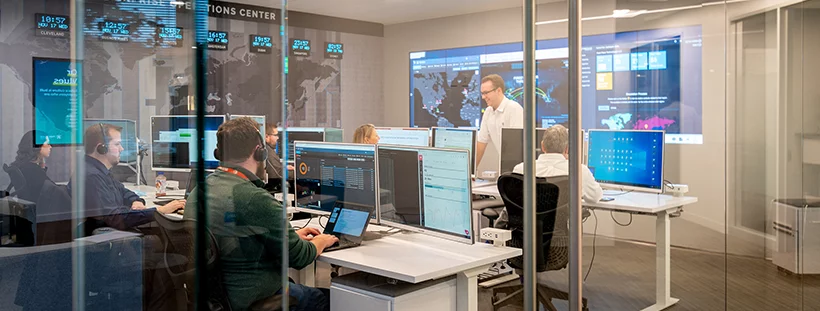Network Traffic Analysis – Methods and How to Analyze
Entuity Software
Networks are built to handle traffic, but not all network activity is the same. It’s important to be able to identify security issues, as well as irregular operations that might lead to problems and even network downtime.
Jump-to Section
What Is Network Traffic Analysis?
Benefits of Network Traffic Analysis
Importance of Network Traffic Analysis
How to Analyze Network Traffic
Agent-Based or Agentless Collection
Getting Started: Small and Diverse
Determine Collection Destination
What to Look for in a Network Traffic Analysis and Monitoring Solution
In this post, we’ll explore network traffic analysis and its role in safeguarding your network’s security and uptime.
What Is Network Traffic Analysis?
Network traffic analysis is the process of analyzing the activity and availability of a network. This operation involves tracking what, when, and where data is flowing across different parts of the network.
Of course, there’s more to it than just monitoring what’s going on. One of the primary goals of this process is to help detect and prevent threats and to monitor for potential problems. To do that, you’ll first need to define what “normal activity” might be.

That’s the beginning of traditional network traffic analysis. Once you set a baseline, you’re able to begin watching for unrecognized device types, unauthorized users, and more.
Benefits of Network Traffic Analysis
Why should you analyze network traffic? It’s about protecting your data sources, ensuring optimal network performance, and identifying potentially dangerous traffic patterns. The benefits of network traffic analysis include:
- Working ahead of intrusion detection systems and intrusion prevention systems
- Providing insights into your network operations
- Accounting for all entities/devices attached to a network
- Identifying and recording the relationships between users, devices, and actions on the network
Importance of Network Traffic Analysis
Network management and security have never been more important. As we move further into the Big Data Age, you can expect that importance to continue increasing.
Network traffic analysis provides the means to automatically detect anomalies, improve network availability, increase network performance, ensure maximum network observability and visibility, and enhance your network’s security. Of course, to enjoy those benefits, you need to know the basics.
How to Analyze Network Traffic
Analyzing network traffic is best done with a purpose-built analysis tool. However, not all solutions are the same. There is no one-size-fits-all approach that will work for all networks and configurations. Instead of discussing what to look for in an analysis tool, it’s more important that you develop an understanding of how to analyze network traffic in the first place. From there you can choose a tool based on your network’s specifics.
Identify Data Sources
The first step is to determine which data sources you’ll use. These can include any device attached to your network, such as routers, servers, firewalls, switches, and desktops. Even applications should be considered important sources of data.
Consider IT asset discovery services or network discovery software to gather an exhaustive inventory of your network.
Agent-Based or Agentless Collection
You must also decide how you will collect data from those sources. You have two choices here – agent-based collection and agentless collection.
Agent-based collection involves the use of software deployed on your data sources. These software-based agents can collect a wide range of information, including data about system resource performance, network communications, and more. However, while the data it yields can be very granular, you can also run into issues with storing the information, as well as processing challenges.

Agentless collection does away with software and instead relies on APIs, varieties of network management protocol, and processes already in place. For instance, SNMP and Netflow can yield a lot of information, as can Syslog when enabled on firewalls. The data retrieved will be less granular, but the demand for storage and processing resources is less.
Recognize Restrictions
All networks have some sort of restrictions that affect data collection and traffic analysis. So which restrictions apply to your network?
- Do you need to open specific ports for information collection?
- Do you need to configure Access Control Lists for the SNMP version (SNMP V1 vs. V2c vs. V3) your network uses?
- Do you need permissions for your organization’s SD-WAN technology?
- Do you need approval from department heads before analyzing traffic or collecting specific information?
- Do you need to break down information silos?
- Are there industry rules or government regulations that affect your efforts?
Getting Started: Small and Diverse
While it’s tempting to jump headlong into network traffic analysis, it’s best to start small. Our recommendation is to begin with a small, diverse data collection test project. You need to use a diverse selection of data sources from across the entire network to help ensure that you’re able to identify any system-related issues before expanding your analysis project across the network. By starting small, you’re able to baby-step your way to a successful, cross-network project.
Determine Collection Destination
Another important part of your project is determining where you’ll store the information you collect. You can choose from many different destinations, including virtual appliances and purpose-built hardware. However, make sure that your storage solution matches the complexity and size of your network.
For instance, if you have a significant number of virtual devices, then virtual storage appliances probably make more sense than other options. If you’re using a largely physical, on-site network, then virtual appliances make less sense.
Finally, remember that storage destination affects analysis capabilities. If your storage appliance doesn’t offer the ability to view data through a web-based user interface, for instance, you’ll discover that analyzing your information is more challenging.

Permit Continuous Monitoring
Understand that monitoring your network is not a part-time task. It’s a full-time responsibility. Make sure you’ve enabled continuous monitoring and data collection through the solution you ultimately implement.
Dashboards & Reporting
It’s also important that you’re able to view, drill into, and manipulate the data that you collect. You should have a single dashboard that offers configurable access to your data in different formats (reporting).
Configure Alerts
Finally, ensure your system can notify you when something’s wrong. Configure alerts via email, as well as through tools like a network fault monitoring system that you and your team use.
What to Look for in a Network Traffic Analysis and Monitoring Solution
Now that we’ve discussed the important aspects of network traffic analysis, we should touch on what to look for in a network analysis tool. Your network traffic analysis tool should offer the following:
- Flow-Enabled Devices – Your network traffic analysis tool will require flow-enabled devices if they only accept specific flows. However, other devices can accept raw flows.
- Data Sources – Make sure that you’re able to collect flow data and packet data from different sources. Not all tools will do this.
- Network Points – Is the tool agent-free or does it use agent-based software? Take your monitoring slow as you begin so that you can scale up accurately.
- Data Types – Will your tool collect real-time data or only historical data? Does the tool retain data as time goes on so that you can compare?
- Full Packet Capture – Full packet capture and retention offers the best picture of your network traffic, but it’s costly and requires extensive appliances. It might be best to choose a tool that extracts just the most critical data from packets rather than storing everything.
Simplify Your Network Analysis Today
Analyzing your network traffic doesn’t need to be stressful. The right partner can meet you where you stand, depending on the current resource utilization of your IT team.
Monitor Network Traffic In-House – If you’ve got the staff to analyze your own network traffic, then leveraging an enterprise network monitoring software like Entuity Software™ is likely the optimal solution. With network device discovery, network topology mapping, and network flow monitoring capabilities built into the core platform, analyzing your critical network insights is easier than ever.
Outsourcing Network Traffic Analysis – If your IT staff doesn’t have the bandwidth to analyze your own network traffic, then outsourcing this function to a trusted network management services provider is the best route. Park Place Managed Services™ is a suite of IT infrastructure managed services designed to take on the monitoring and management of your critical IT systems. This means you can staff-down to weather economic storms without hurting productivity or coverage.
Contact Park Place Technologies today to learn how we can help streamline your IT delivery!


